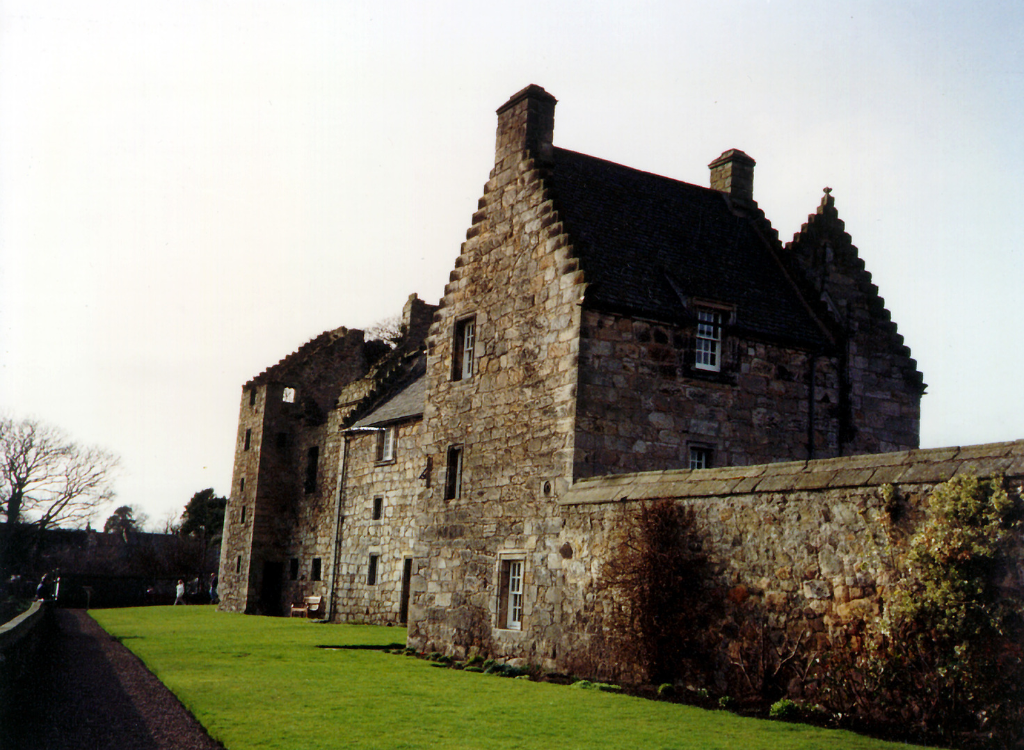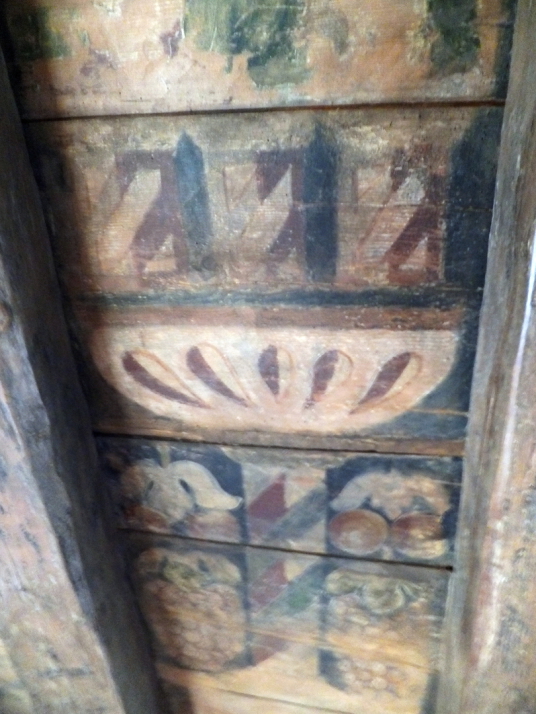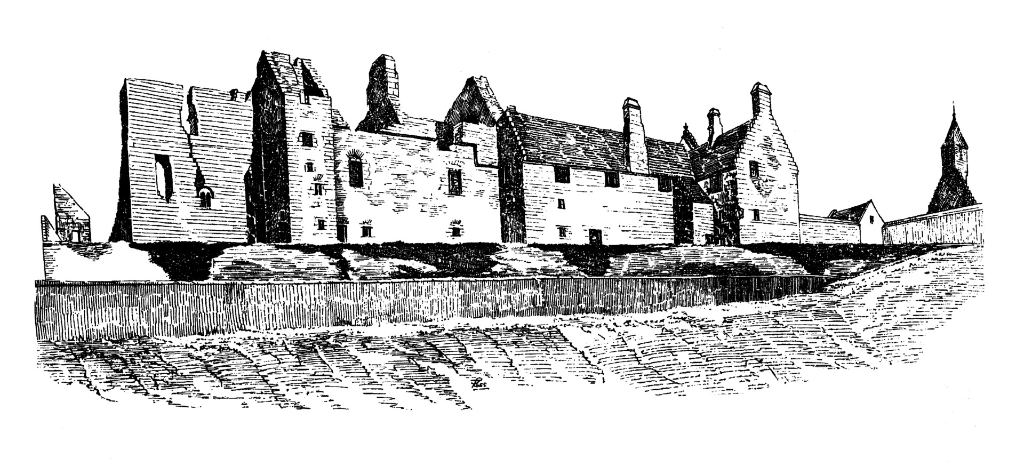–––––– Castle of the Month November 2017 –––––
Aberdour Castle
Aberdour Castle, a scenic old stronghold with terraced and walled gardens and orchard of the Douglas Earls of Morton, in the pretty seaside village of Aberdour in Fife with the picturesque harbour and sandy beaches.
Fife: In Aberdour, south of A921, north of Aberdour harbour, just south of Aberdour railway station, at Aberdour Castle.
HES NT 193854 OS: 66 KY3 0SL
OPEN: Open Apr-Sep, daily 9.30-17.30; Oct, daily 10.00-16.00; Nov-Mar, Sat-Wed 10.00-16.00, closed Thu-Fri; Tearoom open Apr-Oct, daily 10.00-16.30, check winter opening; castle closed 25/26 Dec and 1/2 Jan. Venue for weddings and events.
Tel: 01383 860519 Web: www.historicenvironment.scot
Last updated: 20/3/18
In the attractive village by the railway station, Aberdour Castle is a partly ruinous E-plan tower house, consisting of a ruinous altered 12th- or 13th-century hall house (perhaps the oldest such building in Scotland) and later wings and extensions, some of which are complete.
Buildings, including a bakehouse and brewhouse block, were added in the 16th century, and about 1630 the castle was extended by a block occupied on the first floor by a long gallery. One of the chambers in this range has an original painted ceiling, dating from the early 17th century.
The castle had a walled courtyard, from which a round turret survives. A terraced garden has been restored, and there is an orchard and a beehive doocot, which dates from the 16th century and was still in use in 1746. There is also a fine walled garden.
‘Abyrdour’ is marked on Blaeu’s map of Fife.
This was a property of the Mortimer family, and Sir Alan Mortimer, who held the barony from the 1120s, may have built the castle. One of the family gave his name to Mortimer’s Deep, the stretch of water between Inchcolm and Aberdour, after his coffin was cast overboard there. One story has Mortimer being a wicked fellow and, despite leaving land to the abbey, the monks did not want him buried on Inchcolm and on the journey a storm blew up and Mortimer’s remains were washed overboard; another that the monks themselves were wicked and money grasping, and cast his coffin into the sea to save themslves the cost of his tomb and funeral.
Aberdour was a possession of Thomas Randolph, a friend and captain of Robert the Bruce, by 1325, but in 1342 the property passed to the Douglases, who were Lords of Dalkeith and were made Earls of Morton about 1456.
James Douglas, 4th Earl of Morton, was made Regent Morton for the young James VI in 1572, although in 1581 he was executed for his alleged part in the murder of Henry Stewart, Lord Darnley, the second husband of Mary, Queen of Scots. Morton had had a ratification of 1567 for the lands and barony of Aberdour, with castle, fortalice, manor, mills, fishery, township, woods, parks, gardens, orchards, doocots, warrens etc. He also had a castle that he built later in life at Drochil. The east range with the gallery and painted ceiling was added by William Douglas, 8th Earl of Morton, about 1600.
Much of the castle had been abandoned by 1725, by when the family had moved to nearby Aberdour House, although one wing of the old castle may have been occupied by Robert Watson of Muirhouse until his death in 1791. The 16th-century sundial on the south terrace was formerly at Aberdour House but was moved here when the house was divided, although it is likely it came from the castle.
Part of the castle had been burnt out in 1711, and much of the old tower collapsed in 1844 and then in 1919, although one range was used as a barracks, school room, masonic hall and dwelling until 1924 when the castle was put into the care of State.
There are stories that an apparition of a figure clad in blue has been seen on more than one occasion in the lane to the castle, perhaps the phantom of a stone mason.
Aberdour Castle was Sainte Anne de Beaupre's monastery in France in the TV series Outlander, and the old kitchen and gallery were used for filming.
Aberdour House [NT 192854], was known as Cuttlehill and was a property of the Earls of Moray, but the house and estate were acquired by James Douglas, 11th Earl of Morton, in 1725 after the partial burning of the castle and the property renamed Aberdour House. The house dates from the 17th century, but was extended and remodelled in the 1730s by Robert, the next Earl.
The Douglases held the property into the 20th century, but the house deteriorated. It was sold in the 1990s and has been divided into three flats and houses built in the grounds. It is a long U-plan mansion, rising to two storeys and an attic, with small towers at each end and corbiestepped gables. The prominent obelisk [NT 192851] on Cuttlehill was erected by the Earls of Morton, apparently so that it could be seen from their estate of Dalmahoy near Edinburgh on the other side of the Firth of Forth.
The nearby church of St Fillan’s [NT 193855], which later became the parish church, dates from the 12th century, although it was much altered in the 17th. It became ruinous, but was restored in the 19th century and there is a stained glass window paid for by the Coventry family. The church stands in a lovely peaceful spot, and the burial ground has many interesting memorials. Another point of interest is the holy well [NT 194854], located in a garden adjacent to the burial ground.






































